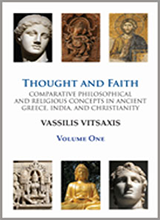Vassilis Vitsaxis – Thought and Faith: Comparative Philosophical and Religious Concepts in Ancient Greece, India, and Christianity. Reviewed by Thomas Cattoi
(Theological Studies, December 2010. Thomas Cattoi teaches at Jesuit School of Theology of Santa Clara University at Berkeley.)
This massive study by the former Greek ambassador to the United States is an encyclopedic attempt at a comparative reading of classical Greek philosophy, early Christian theology, and different currents of Indian thought. This type of grand synthesis is shunned by the majority of English-speaking scholars who are more likely to address methodological questions (as in Francis Clooney's seminal Theology after Vedanta, 1993) or explore more specific themes, such as "salvation"' or "truth" (as in the Comparative Religions Ideas Project edited by Robert Neville). Vitsaxis works in a 19th-century tradition of Continental scholarship that is not afraid to channel the history of thought into sweeping overarching systems; his organizing concept is an old-fashioned perennialist conviction that one may trace the same philosophical themes within different schools.
Throughout his 1200 pages, Vitsaxis's position remains tantalizingly ambiguous. On the one hand, he is not writing from an explicitly theological standpoint; on the other hand, he clearly echoes the tradition of the early Greek Fathers, for whom Christian theology brings to completion whatever elements of truth are present in non-Christian traditions. In the prologue (1:6-11) he rejects "absolute standards" to adjudicate between different philosophical positions, but this rejection differs not at all from the critique of "natural theology" one finds among the majority of Orthodox theologians.
Volume 1 addresses four themes: revelation, redemption-salvation, time, and the tripartite nature of God. Volume 2 focuses on cosmology, comparing monotheistic accounts of the origin of the universe to polytheistic or henotheistic accounts.
This is an unusual work of great erudition, largely targeting a nonacademic audience, but its sheer size is likely to limit its appeal. Vitsaxis might have achieved more by reaching for less.
COPYRIGHT 2010 Theological Studies, Inc.
COPYRIGHT 2010 Gale, Cengage Learning

